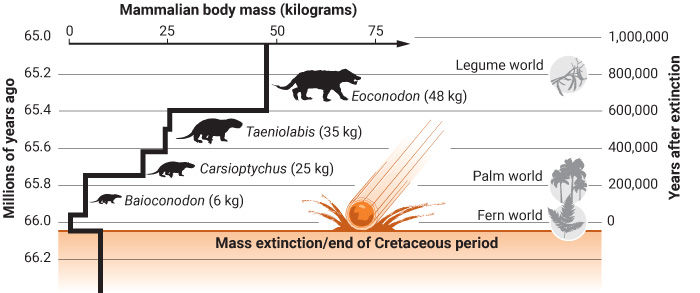How Life Blossomed after the Dinosaurs Died

In 2014, when Ian Miller and Tyler Lyson first visited Corral Bluffs, a fossil site 100 kilometers south of the Denver Museum of Nature & Science where they work, Lyson was not impressed by the few vertebrate fossils he saw. But on a return trip later that year, he split open small boulders called concretions—and found dozens of skulls. Now, he, Miller, and their colleagues have combined the site's trove of plant and animal fossils with a detailed chronology of the rock layers to tell a momentous story: how life recovered from the asteroid impact that killed off the dinosaurs 66 million years ago.
Plants and animals came back much faster than thought, with plants spurring mammals to diversify, the team reports today in Science. "They get almost the whole picture, which is quite exciting," says functional anatomist Amy Chew of Brown University. "This high-resolution integrated record really tells us what's going on."
When the asteroid slammed into Earth, it wiped out 75% of living species, including any mammal much larger than a rat. Half the plant species died out. With the great dinosaurs gone, mammals expanded, and the new study traces that process in exquisite detail.
Most fossil sites from after the impact have gaps, but sediment accumulated nearly continuously for 1 million years on the flood plain that is now the Corral Bluffs site. So the site preserves a full record of ancient life and the environment.
Such sites can be hard to date. But Miller, a paleobotanist, and his colleagues collected 37,000 grains of pollen and spores, which revealed a clear marker of the asteroid impact: a surge in the growth of ferns, which thrive in disturbed environments. The site also includes two layers of ash from nearby volcanoes. Volcanic ash includes radioactive minerals whose decay can be used as a precise geochronological clock, providing two time markers. The known flips in Earth's magnetic poles, which some minerals in the layers had recorded, add detail to the chronology. "They have a very strong geochronological framework," says David Fastovsky, a paleontologist at the University of Rhode Island in Kingston.
The record confirms the devastation wrought by the impact. Raccoon-size mammal species had swarmed the site before the catastrophe, but for 1000 years afterward just a few furry creatures no bigger than 600-gram rats roamed a ferny world where flowering plants, with their nutritious seeds and fruits, were scarce.
By 100,000 years later, twice as many mammal species roamed, and they were back to raccoon size. These critters foraged in the palm forests that replaced the ferns. "It's a world that's coming back from complete and utter devastation," Miller says.
Over the next 200,000 years, what he calls the "palm period" gave way to the "pecan pie" period, when walnutlike plants arose. New mammals evolved to take advantage of the nutritious seeds. Mammal diversity increased threefold, and the biggest of the new species reached 25 kilograms—beaver size.
A stepwise recovery
After an asteroid wiped out much of life on Earth, mammals—responding to changes in plants—grew in size and diversity surprisingly quickly.

Denver Museum of Nature and Science, Adapted by C. Bickel/Science
After about 700,000 years, legumes showed up; their fossil pea pods are North America's oldest discovered to date. Pea and bean species from the "protein bar period" provided protein-rich meals that further boosted mammalian size and diversity, Lyson says. Mammals topped 50 kilograms—a 100-fold increase over those that survived the asteroid. The forests, too, had recovered. "The biggest message is how fast the recovery was … and how closely the vegetation and fauna are tied together," says Vivi Vajda, a paleobiologist at the Swedish Museum of Natural History in Stockholm.
The team also classified 6000 leaves, counting how many species at each time interval had smooth or toothed edges. Smooth-edged species are more common in hot climates. The team concluded that the site underwent three warming periods. They estimate that the first, just after the impact, saw temperatures rise about 5°C, agreeing with earlier work. This period coincides with the massive volcanic eruptions of India's Deccan Traps, which could have warmed Earth by belching carbon dioxide.
"At each warming period you see a change in the plant community and subsequently, changes in the mammals," says Lyson, who thinks temperature drove the stepwise recovery.
Vajda thinks no matter what happened to temperature and plant life, the loss of dinosaurs alone might have opened the door to bigger, more diverse mammals. But Jukka Jernvall, an evolutionary biologist at the University of Helsinki, says the team's analysis of ancient ecosystems shows just how the recovery unfolded. "We are starting to get the time and spatial resolution to reconstruct the environment and what happened in a way that can be linked to ecological processes."
The record also holds a sobering message about the future, and how quickly ecosystems might recover from ongoing, human-driven extinctions. Even a recovery that geologists call "fast" took hundreds of thousands of years, and the world was never the same. "A very dramatic resetting of the ecosystem could be in our future," Chew says.
Elizabeth Pennisi writes about biology, focusing primarily on genomics, evolution, microbiology, and organismal biology, with a smattering of ecology and behavior thrown in. She joined the staff of Science in 1996 and added editing to her job duties in 2007. She has an undergraduate degree in biology from Cornell University and a master's degree in science writing from Boston University. In addition to Science, her byline has appeared in Science News--where she won the James T. Grady-James H. Stack Award for Interpreting Chemistry for the Public—The Scientist, and United Press International.
Although she loves being a science writer, Liz is most passionate about the outdoors and in particular about whitewater kayaking and outrigger canoeing.
